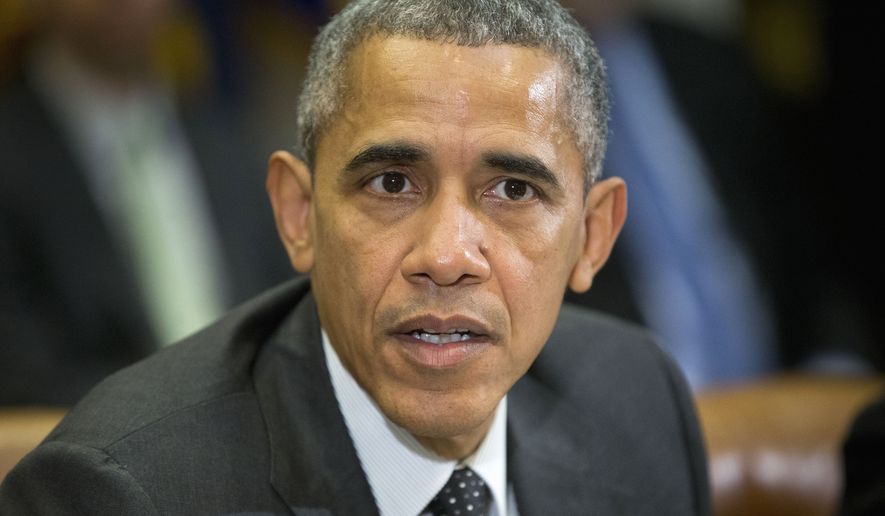The Supreme Court halted the EPA’s major anti-global warming initiative late Tuesday evening, dealing a major blow to President Obama’s hopes of overseeing a green energy transition in his final year in office.
The 5-4 decision by the court puts the Environmental Protection Agency’s regulation on hold while a lower appeals court hears states’ challenge to the rules.
More than two dozen states sued to stop the rules, which were intended to control greenhouse gas emissions from existing power plants.
The EPA called the court’s decision disappointing but said it won’t stop the agency’s determination to press forward.
“You can’t stay climate change, and you can’t stay climate action,” spokeswoman Melissa J. Harrison said. “Millions of people are demanding we confront the risks posed by climate change. And we will do just that.”
Energy advocates had predicted the rules would force a major shift in the economy, pushing energy companies and consumers toward solar and wind power and away from the fossil fuels that currently underpin most electricity in the U.S. Estimates suggested consumers’ power bills would leap at least 25 percent, with some estimates putting the hike much higher.
“This wasn’t a rule so much as it was a reimagining of the entire electricity system of the United States,” said Michael McKenna, a Republican energy strategist.
While Tuesday’s stay isn’t a ruling on the actual merits of the EPA’s regulations, energy industry backers said it suggested a majority of the justices are skeptical of what Mr. Obama did.
The four Democrat-appointed justices on the Supreme Court dissented from the order granting the stay.
Known as the Clean Power Plan, the EPA’s regulation was intended to impose strict limits on the carbon emissions from existing power plants. It followed a rule on new power plants, but the industry said the restrictions on existing plants is tougher because it requires retrofitting — or shutting down — plants that can’t meet goals.
States were supposed to submit preliminary plans for how they would meet their emissions goals to the EPA later this year, with final plans slated for 2018.
The goal was to reduce emissions about 30 percent by 2030.
States were scrambling to decide whether to submit plans or wait it out. The Supreme Court’s stay will bolster states that took a wait-and-see approach — and likely pushes the big decisions beyond Mr. Obama’s tenure and straight into this year’s presidential election.
Mr. Obama came into office expecting major climate change legislation from Congress, but he failed to win over Senate Democrats in 2009 and 2010.
When Republicans took control of the House in 2011, the president changed tactics and began threatening executive action, hoping to pressure Congress to act. But after continued resistance from Capitol Hill, Mr. Obama struck out on his own last year.
It’s another in a long list of areas where the Obama administration did an end run around Congress.
Mr. Obama’s deportation amnesty for illegal immigrants, announced in late 2014, has also been halted by courts, with judges ruling that Mr. Obama broke procedural and immigration laws.
That immigration case is now pending before the Supreme Court, where the justices have asked attorneys to address even bigger questions of whether Mr. Obama violated the Constitution.
A lower court refused to halt the power plant rules last month while the appeals court heard the case.
The White House at the time cheered the move, insisting it had acted legally, and repeated that assertion Tuesday.
“We remain confident that we will prevail on the merits. Even while the litigation proceeds, EPA has indicated it will work with states that choose to continue to plan development and will prepare the tools those states will need,” said White House press secretary Josh Earnest.
The U.S. Court of Appeals for the District of Columbia is expected to hear oral arguments in the case in June.
Congress voted to try to overturn the rules, but Mr. Obama vetoed the disapproval and Democrats sustained his veto.
A senior administration official said Obama advisers were “very surprised” by the court’s decision, calling it unprecedented to stay a rule that had not been implemented.
Obama officials said the decision is a “temporary procedural determination” and they’re not worried that it could persuade other nations to withdraw from the groundbreaking climate accord that Mr. Obama sealed with 195 nations in Paris in December.
Mr. Obama pointed to the Clean Power Plan as proof of the U.S. commitment to lead the world in reducing emissions.
Obama aides also said they are not concerned about the possibility of the case going to the Supreme Court.
“We don’t think the Supreme Court’s been hostile,” one official said, adding that the high court has generally been “supportive and deferential” to EPA actions.
Sen. James M. Inhofe, Oklahoma Republican and chairman of the Senate Environment and Public Works Committee, said the court’s stay was a “major blow” to the promises Mr. Obama made to other world leaders late last year that the U.S. would reduce emissions.
“These regulations were the foundation of the president’s commitment to the Paris Climate Agreement,” Mr. Inhofe said. “The court’s action should demonstrate once again to the world that this president has committed the U.S. to actions that are unenforceable and legally questionable.”
But House Minority Leader Nancy Pelosi, California Democrat and one of the driving forces in Congress behind tackling global warming, called the court’s stay “deeply misguided.”
“In the face of rising asthma rates, record droughts and surging oceans, there can be no question: The damage of carbon pollution threatens the health of our children, the strength of our economy and the security of our nation,” she said.
“We cannot afford more willful blindness to the reality or the severity of the climate crisis.”
• Stephen Dinan can be reached at sdinan@washingtontimes.com.




Please read our comment policy before commenting.